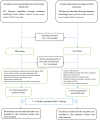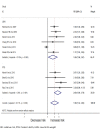Antenatal depression and its association with adverse birth outcomes in low and middle-income countries: A systematic review and meta-analysis
- PMID: 31923245
- PMCID: PMC6953869
- DOI: 10.1371/journal.pone.0227323
Antenatal depression and its association with adverse birth outcomes in low and middle-income countries: A systematic review and meta-analysis
Abstract
Background: Depression in pregnancy (antenatal depression) in many low and middle-income countries is not well documented and has not been given priority for intervention due to competing urgencies and the belief that it does not immediately cause fatalities, which mainly emanated from lack of comprehensive research on the area. To fill this research gap, this systematic review was conducted to investigate the burden of antenatal depression and its consequences on birth outcomes in low- and middle-income countries.
Methods: We systematically searched the databases: CINHAL, MEDLINE, EMCare, PubMed, PSyc Info, Psychiatry online, and Scopus for studies conducted in low and middle-income countries about antenatal depression and its association with adverse birth outcomes. We have included observational studies (case control, cross-sectional and cohort studies), written in English-language, scored in the range of "good quality" on the Newcastle Ottawa Scale (NOS), and were published between January 1, 2007 and December 31, 2017. Studies were excluded if a standardized approach was not used to measure main outcomes, they were conducted on restricted (high risk) populations, or had fair to poor quality score on NOS. We used Higgins and Egger's to test for heterogeneity and publication bias. Primary estimates were pooled using a random effect meta-analysis. The study protocol was registered in PROSPERO with protocol number CRD42017082624.
Result: We included 64 studies (with 44, 035 women) on antenatal depression and nine studies (with 5,540 women) on adverse birth outcomes. Antenatal depression was higher in the lower-income countries (Pooled Prevalence (PP) = 34.0%; 95%CI: 33.1%-34.9%) compared to the middle-income countries (PP = 22.7%, 95%CI: 20.1%-25.2%) and increased over the three trimesters. Pregnant women with a history of economic difficulties, poor marital relationships, common mental disorders, poor social support, bad obstetric history, and exposure to violence were more likely to report antenatal depression. The risk of having preterm birth (2.41; 1.47-3.56) and low birth weight (1.66; 1.06-2.61) was higher in depressed mothers compared to mothers without depression.
Conclusions: Antenatal depression was higher in low-income countries than in middle-income countries and was found to be a risk factor for low birth weight and preterm births. The economic, maternal, and psychosocial risk factors were responsible for the occurrence of antenatal depression. While there could be competing priority agenda to juggle for health policymakers in low-income countries, interventions for antenatal depression should be reprioritized as vitally important in order to prevent the poor maternal and perinatal outcomes identified in this review.
Conflict of interest statement
The authors have declared that no competing interest exist.
Figures





References
-
- WHO. Depression and other common mental disorders: global health estimates. World Health Organization; 2017.
-
- Wang H, Naghavi M, Allen C, Barber RM, Bhutta ZA, Carter A, et al. Global, regional, and national life expectancy, all-cause mortality, and cause-specific mortality for 249 causes of death, 1980–2015: a systematic analysis for the Global Burden of Disease Study 2015. 2016;388(10053):1459–544. - PMC - PubMed
Publication types
MeSH terms
LinkOut - more resources
Full Text Sources
Medical
Research Materials
Miscellaneous

